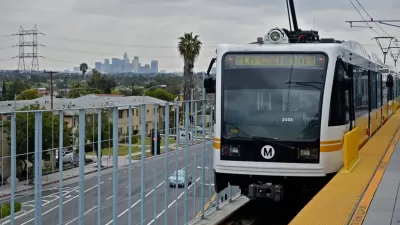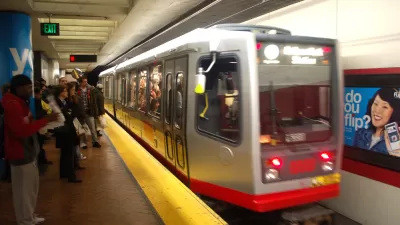A report by Next 10 takes the form of a scorecard for six light and heavy rail networks. Rail that serves existing urbanized areas scored the highest.
"The analysis was done by the Center for Law, Energy and the Environment at UC Berkeley and Next 10, a nonprofit organization that funds research into state issues," writes transportation reporter Dan Weikel for the Los Angeles Times.
The study, which was released Monday evening, evaluated 489 rail transit stations and the neighborhoods within a half-mile of each. The researchers graded the stations on "how well they encourage ridership and create thriving, rail-oriented neighborhoods," the report said.
The report determines "which transit stations serve as hubs of thriving, walkable areas that encourage residents and workers alike to ride the train, and which station areas need improvement," according to the introduction to the report on the Next 10 webpage.
Weikel goes into the greatest detail, as one might expect, on the Los Angeles County Metropolitan Transportation Authority (aka Metro Rail) rail stations, which received an average 'C' grade. However, "most of its subway and light-rail stations scored well, including Westlake/MacArthur Park, which was called a model for transportation agencies," writes Weikel.
Receiving lower grades were the San Diego Trolley and Santa Clara Valley Transportation Authority. Tops was San Francisco Municipal Transportation Authority (MUNI) followed by BART. Sacramento Regional Transit tied Metro for average.
Best rail station in California: Market and Church. There's an underground Market Street station there as well as a surface station
"San Francisco has many more built-in advantages compared to L.A.," said Ethan Elkind, the main author of the study. "There are more walkable neighborhoods. People are more likely to ride transit if they live near stations. MUNI was built before the advent of the automobile and the city is high-density."
More press coverage can be found on the Next 10 introduction to the report. Related articles can be found under the tag 'transit stations.'
Hat tip: Darrell Clark, transit advocate.
FULL STORY: Metro receives average rating in statewide evaluation of rail transit stations

Planetizen Federal Action Tracker
A weekly monitor of how Trump’s orders and actions are impacting planners and planning in America.

The Simple Legislative Tool Transforming Vacant Downtowns
In California, Michigan and Georgia, an easy win is bringing dollars — and delight — back to city centers.

San Francisco's School District Spent $105M To Build Affordable Housing for Teachers — And That's Just the Beginning
SFUSD joins a growing list of school districts using their land holdings to address housing affordability challenges faced by their own employees.

In More Metros Than You’d Think, Suburbs are Now More Expensive Than the City
If you're moving to the burbs to save on square footage, data shows you should think again.

The States Losing Rural Delivery Rooms at an Alarming Pace
In some states, as few as 9% of rural hospitals still deliver babies. As a result, rising pre-term births, no adequate pre-term care and "harrowing" close calls are a growing reality.

The Small South Asian Republic Going all in on EVs
Thanks to one simple policy change less than five years ago, 65% of new cars in this Himalayan country are now electric.
Urban Design for Planners 1: Software Tools
This six-course series explores essential urban design concepts using open source software and equips planners with the tools they need to participate fully in the urban design process.
Planning for Universal Design
Learn the tools for implementing Universal Design in planning regulations.
Smith Gee Studio
City of Charlotte
City of Camden Redevelopment Agency
City of Astoria
Transportation Research & Education Center (TREC) at Portland State University
US High Speed Rail Association
City of Camden Redevelopment Agency
Municipality of Princeton (NJ)





























